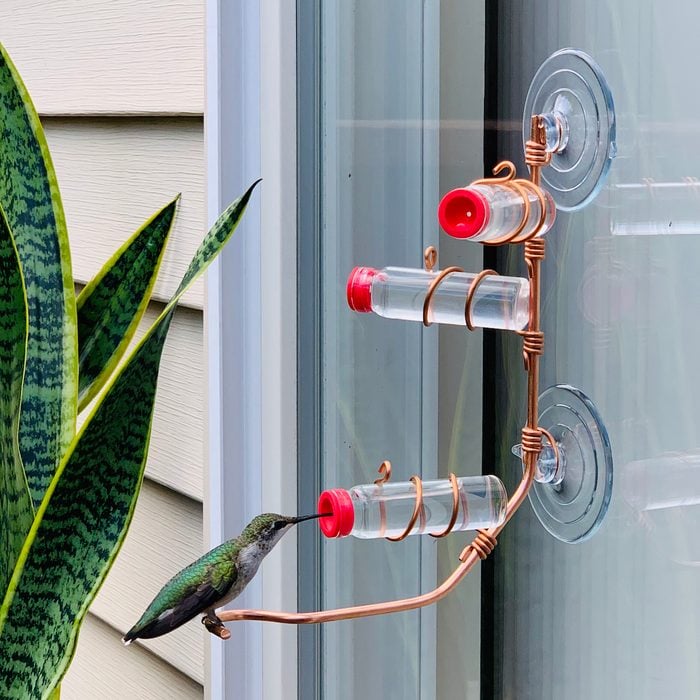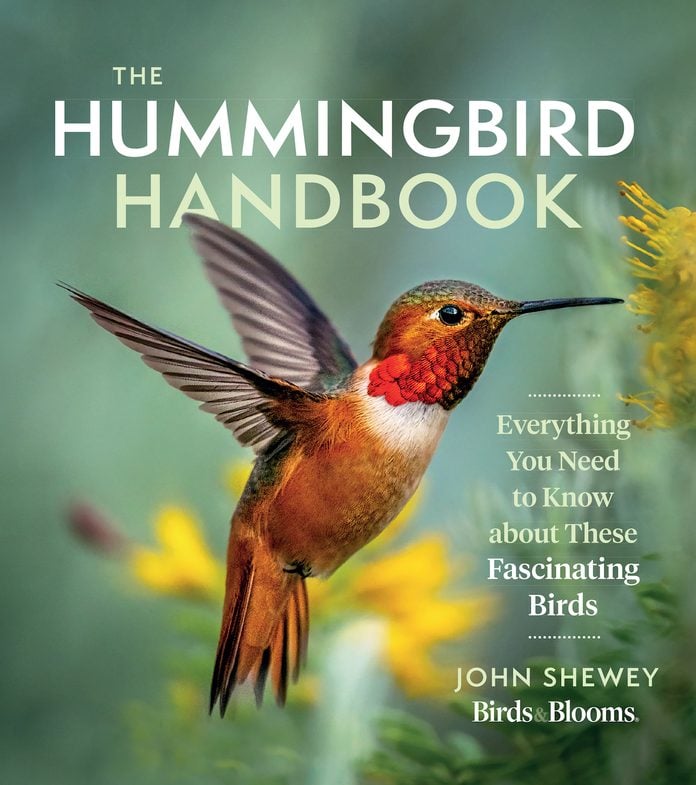
Watching birds at backyard feeders is one of life’s greatest simple joys—but with that joy comes responsibility. “Just like you wash your own dishes for guests before you have a party, it’s good to clean your bird feeders periodically,” says Emma Grieg, project leader for the Cornell Lab of Ornithology’s Project FeederWatch. “It helps reduce the spread of diseases transmitted by germs left by sick birds.”
A clean bird feeder is essential, and it’s definitely something to keep in mind when you’re buying or building a new one. In addition to how attractive the feeder looks, how sturdy it feels, and how much seed it holds, consider how to clean your bird feeders.
When birds eating at feeders come in close proximity, the spread of bird disease is more likely. Summer heat and rains can cause seed and suet to spoil or mold much quicker, especially if your feeders are in the sun. Accumulated bird droppings also create an unhealthy environment. Follow the steps below to keep your bird feeders clean.
Check out the best bird feeders and birdseed for cardinals.
How Often to Clean Bird Feeders

It’s important to keep feeders and the surrounding area clean to avoid spreading illness such as bird flu. Emma recommends cleaning your seed and suet feeders feeders every two weeks. It’s important to regularly check your birdseed, suet and other foods to ensure they haven’t gone moldy or rancid, especially in hot or wet weather.
Always be on the lookout for signs of disease; a vigilant eye keeps backyard visitors healthy, so they can continue to delight you daily. If you see sick birds, you will need to clean them more frequently or even consider taking your feeders down temporarily. But if you have few visitors and everyone seems healthy, you can clean a little less often.
“One of the most important things you can do is keep your eyes peeled for sick birds, and report them to your local wildlife agencies,” Emma says.
Scrub, Rinse, Repeat
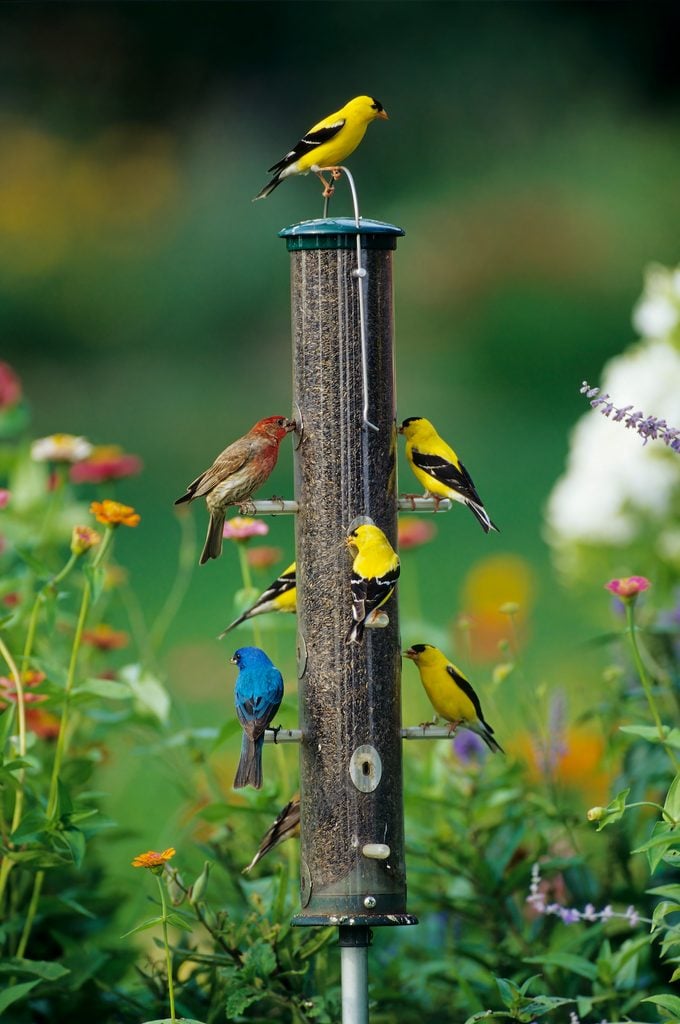
Remove and discard any leftover seed and dust off feeders to remove debris. Spray and wipe feeders with a 10 percent bleach solution (one part bleach to nine parts water) and a stiff brush — an old toothbrush is a perfect choice. A solution of 1 part vinegar to 2 parts water works, too. If a feeder has a lot of caked-on grime, soak it in warm water.
Alternatively, you can use the hottest water possible and dish soap. Either way, rinse the feeders well with clean water once you’re done scrubbing to remove any residue. Allow feeders to dry completely before filling and putting them back up. Wipe down poles and baffles as part of your cleaning routine.
Many birds feed on the ground, so be sure to periodically sweep up and discard the husks and dropped seeds that have accumulated on the ground underneath your feeders. This will also prevent visits from raccoons, mice and other pests.
Check out the 10 types of bird feeders you need in your backyard.
Mild days in early spring are the perfect time to assess the condition of feeders that have been outside all winter. Check for cracks, broken perches or damaged baffles. Repair or replace them if necessary.
Next, follow these tips to learn how to clean hummingbird feeders, how to clean suet cage feeders and how to clean a bird bath.
Steps for Cleaning a Hummingbird Feeder

Sugar water feeders are an easy way for backyard birders to attract more hummingbirds, but it’s important to clean the feeders to keep birds healthy. In general, the best advice on how to clean a hummingbird feeder is to follow the same general steps that you would for cleaning seed feeders. This means taking the feeders down, emptying any leftover sugar water, and scrubbing them with hot water and dish soap. You can also use a bleach solution (made from 1 part bleach to 9 parts water) or a vinegar solution (1 part vinegar to 2 parts water). Make sure you rinse all parts thoroughly with clean water before refilling them.
You’ll need to clean hummingbird feeders more frequently than other feeders. Aim to scrub them once a week in cooler weather and twice a week when temperatures soar. If you’re crunched for time, Emma Grieg, project leader for the Cornell Lab of Ornithology’s Project FeederWatch, has a tip. “Running them through a dishwasher will do the trick,” she says.

Droll Yankees Cleaning Brushes
When washing the feeders by hand, pay special attention to the feeding ports. A pipe cleaner can help get the ports squeaky clean, as can special microbrushes. Use this three-pack of little brushes to scrub tiny ports on sugar-water feeders.
Here’s how to clean a suet cage feeder.

More Birds Milk Bottle Hummingbird Feeder
This glass bottle hummingbird feeder has a wide opening and comes apart for easy cleaning. Place hummingbird feeders in spots tucked away from the sun during the hottest part of the day to keep nectar fresh longer.
Read on for more hummingbird feeder cleaning tips shared by Birds & Blooms readers.
How to Clean a Hummingbird Feeder in 5 Ways

Rotate Hummingbird Feeders
“I have several feeders so that I can swap them out for cleaning. I soak them in bleach and water to get the black residue off. Then I use Q-tips to scrub the holes and small nooks. Rinse thoroughly!” says Lu-Ann Tucker of Wareham, Massachusetts.
When should I clean out my bird houses?
Keep Hummingbird Feeders in the Shade

“Feeders are easier to keep clean if they’re hung in the shade. Mold growth slows significantly,” says Barbara Cameron of Cogan Station, Pennsylvania.
Learn how to clean a bird bath.
Reuse an Old Toothbrush
“Wash (feeders) with very warm water and scrub with a toothbrush,” says Emily Eigenbrode Frederick, Maryland.
Get answers to your frequently asked questions about feeding hummingbirds.
Clean Hummingbird Feeders Often
“I clean hummingbird feeders every three days, especially in hot humid weather, using hot water, a natural cleaner and a special bent brush for hard-to-reach places,” says Gayla Metzger of Battle Creek, Michigan.
Psst—never add these foods to your hummingbird mixture. This is the only homemade hummingbird nectar recipe you need.
Just Add Rice
“I put 1/4 cup of rice and 1/2 cup of hot water in a feeder and shake it. The rice is abrasive, so it cleans the inside of the feeder,” says Kerry Rose of Valleyford, Washington.
Next, discover jaw-dropping hummingbird facts.
Benefits of Growing Lavender

Lavender is one of the best-known perennial plants—if not by sight, then by smell. It’s hard to argue with the beauty of its fragrance, silver-gray foliage and spiky flowers—which, as you might suspect, are often lavender-colored, although purple, pink and white blooms are also available.
Discover 7 essential facts about lavender plants.
Caring for Lavender
Native to rocky hillsides in the Mediterranean, lavender prefers hot, dry summers and cool, moist winters, so it’s right at home on Donna Anderson’s Lavender Acres farm in Meridian, Idaho. But it can be grown elsewhere if the conditions are right. In addition to six to 10 hours of sunlight, lavender needs lighter, well-draining alkaline soil and special care when watering.
“Many homeowners will put lavender in their landscaping and let the lawn sprinklers water it,” Donna says. But, she points out, grass requires a lot more water than lavender does, and too much water can kill the fragrant plant.
Small, bushy and a perennial, lavender grows 1 to 3 feet tall, depending on the species or cultivar.
Once your lavender is established, it is low maintenance, requiring only an annual trim to encourage growth and keep it tidy. “Depending on the location of the lavender, you can prune in the fall if it is pruned at least six weeks before heavy frost,” Donna says. If you live in an area with harsh winters, prune in late March or April.
Check out the best-smelling flowers to add to your garden.
Tips for Growing Lavender Indoors

If lavender isn’t winter hardy in your area, you may be able to overwinter it indoors before bringing it back outside in warmer weather. Overwinter it in a large pot placed in a cool room. Other things to consider:
- Lighting: Lavender needs plenty of bright, natural lighting, so place it near a south-facing window.
- Soil: Use a lightweight potting mix augmented with sand and gravel in a quick-draining terra-cotta pot. Test the soil and add limestone if the pH result is below 7.0.
- Watering: Wet the plant’s base only, not the leaves or blooms. Let the soil dry out slightly between waterings.
Discover more easy perennial plants that anyone can grow.
Best Types of Lavender for Growing in Your Region

Lavender has three main types: English, English hybrids and non-English, which include Spanish, French, sweet and woolly. Their winter hardiness varies between categories. Count on French lavender (Lavandula stoechas) to thrive in Zones 8 to 10, while English lavender (L. angustifolia) can take the colder temperatures of Zones 5 to 9. (Psst–here’s how plant zones work and how to find yours.)
Although lavender can be grown in many parts of the country, Donna suggests doing some research. “There are tiny microclimates in all areas, so a lavender variety that grows well for one grower might not grow as well for another 5 miles away,” she says.
Follow this guide to find the perfect type of lavender for your yard, and reach out to your local nursery or university extension service for their recommendations.
Southeast
- Grosso, French hybrid
- Munstead, English
- Provence, French
- Spanish types
Pacific Northwest
- Folgate, English
- Royal Velvet, English
- Super, English hybrid
- Violet Intrigue, English
Northeast and Midwest
Southwest
- Grosso, French hybrid
Next, check out the top purple flowers that attract hummingbirds.

Even if you live in an apartment building or simply don’t have a yard, garden or trees, you can still enjoy the birds. There are window bird feeders you can put right on your windows with suction cups. “A window bird feeder can keep mealtimes interesting,” says wildlife artist Heather Bartmann of Fort Collins, Colorado. Her main visitors are house sparrows, but even the most common birds are fun to watch if you can observe their behavior up close.
Serve birds their favorite seeds in an acrylic window bird feeder if you are tight on space. Buy one with suction cups to attach to a pane of glass, and make sure it has tiny perches for songbirds. The small perches prevent bully birds, like grackles and pigeons, from gaining access to the seeds. You can also find window hummingbird feeders and suet feeders.
After all, one very important consideration when it comes to setting up feeders is yourself! The better your view of the birds, the more you’ll get to enjoy them. Ultimately, the best seat in the house is wherever you can easily see the birds.
And don’t worry—window bird feeders are not dangerous to the birds. To prevent bird strikes on windows, feeders should be within 3 feet or outside of 10 feet of all windows. Learn how to help a bird that flew into a window.
The Best Window Bird Feeders
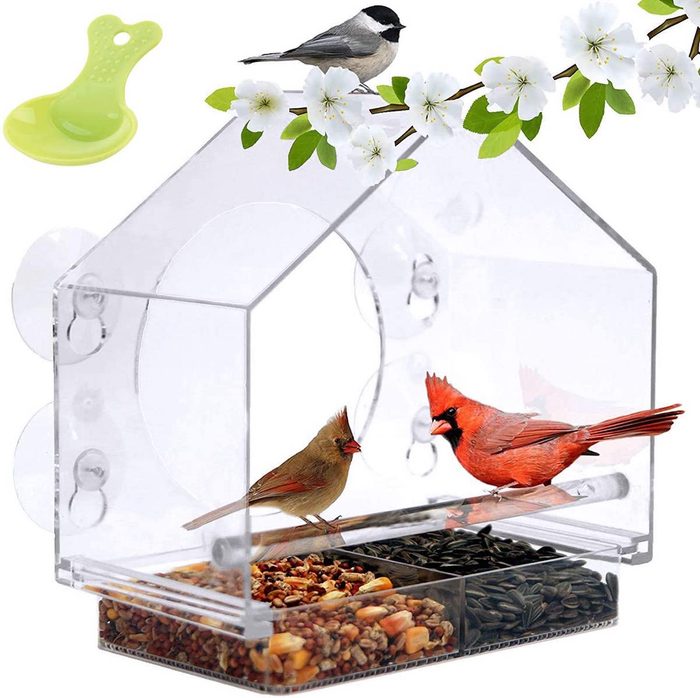
Window Bird House Feeder
This plastic birdhouse shaped feeder attaches to the window to give you a clear view of the birds. It includes a small perch and two removable seed trays (for easy cleaning!), so you can offer more than one type of birdseed. A sloped roof offers protection from the rain.
Check out the best bird feeders and seed for cardinals.
Large Platform Window Feeder
This heavy-duty open platform feeder will accommodate larger birds like mourning doves and even squirrels without falling down. It is handmade of durable red cedar wood with a mesh aluminum bottom for drainage.
Check out the best squirrel-proof bird feeders and 12 tips that work.
Kettle Moraine Window-Mount Suet Feeder
Try a window-mount suet feeder to get close-up looks at chickadees, nuthatches and woodpeckers. Two strong suction cups hold it firmly in place.
Don’t miss the best-selling bird feeders for 2022.

Gray Bunny Window Bird Feeder
This is a simple and effective window feeder at an affordable price. This feeder may attract black-capped chickadees, northern cardinals, house finches and American goldfinches. The suction cups hold a strong seal and the feeder is easy to take down and clean. The clear acrylic material gives you (and your pets!) a front row seat to view your favorite feathered friends. Try filling it with sunflower seeds, mealworms, suet nuggets and more!
Discover the 10 types of bird feeders you need in your backyard.

Nature Anywhere Window Hummingbird Feeder
This is a traditional bottle hummingbird feeder with a twist—it attaches directly to the window with three industrial strength suction cups. The bottle is easy to remove from the metal bracket base for filling and cleaning. And it is guaranteed to never fall down.
We found the best sunflower seed bird feeders for your yard.
Aspects Jewel Box Window Hummingbird Feeder
If you prefer a saucer style hummingbird feeder, try this version that attaches to the window with a suction cup bracket. It includes a built-in ant moat tray that wraps around the feeder and a perch for the birds to rest. The feeder portion lifts out of the base for cleaning, and the lid is hinged for easy sugar-water refills.
Copper Window Mount Hummingbird Feeder
These tiny tubes are just the right size for tiny hummingbirds. Keep in mind that they will need to be filled much more often than a larger nectar feeder. We love the pretty copper perch that looks like a tree branch.
Check out the best finch feeders to serve thistle seed.
How to Make a DIY Window Bird Feeder
Create a window shelf, a simple board nailed to the sill, “to enjoy the birds at very close quarters,” ornithologist Roger Tory Peterson urged 85 years ago in Bird-Lore magazine. After all, the benefits of bird feeding are for you just as much as for the birds.
“I attach a board to the window ledge and sprinkle sunflower seeds across it. The birds come to the makeshift feeder even with me watching. The key is nearby shrubs that offer the birds protection,” says Grace Huffman of Oklahoma City, Oklahoma.
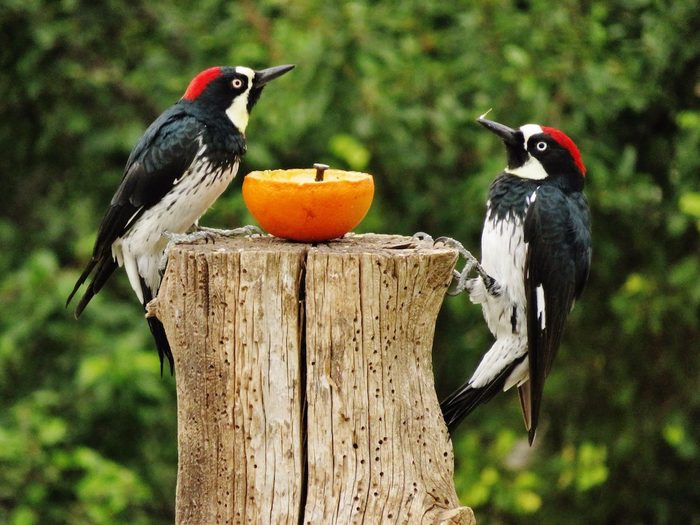
If you have a deck railing or a patio, here’s a simple trick to see orioles and other fruit-eating birds up-close—just spear an orange half on a nail!
Next, check out the best blue jay bird feeders for peanuts.
All About Hens and Chicks Plant

Hens and chicks sports a unique moniker that might make you laugh, but it makes sense. The plant was named for the rosette shape at the plant’s center and the smaller growths sprouting from it. (Kind of like a hen and baby chicks, right?)
Hens and chicks is a particularly excellent choice for beginning succulent gardeners. Some varieties are hardy all the way down to Zone 3, embracing chilly and frosty conditions. It’ll grow in tight spaces where few other plants would dare to take root, and it’s a perfect choice for container gardens or even fairy gardens.
Psst — did you know hens and chicks is one of the best succulents to attract pollinators?
How to Grow Hens and Chicks Succulents

Botanical Name
The botanical name for hens and chicks plant is Sempervivum tectorum.
Add haworthia, or zebra plant, to your succulent collection
Light
This succulent prefers bright light and sunny conditions, but will tolerate light shade. In the correct growing conditions, a hens and chicks plant can spread up to 20 inches wide. You’ll get plenty of bang for your buck!
These are the top 10 colorful succulents you should grow.
Water
Hens and chicks doesn’t need much water at all. In fact, you’d likely be better off forgetting to water it than overwatering it. This plant needs well-draining soil. It will not do well in soggy, wet soil.
Discover more drought-tolerant plants that can handle dry weather.
Growing Zones
Most types of the hens and chicks plant grow outdoors in Zones 4 to 8. Some will also grow in Zone 3, while most won’t be able to handle the heat and humidity of Zones 9 to 11. However, you can also grow them indoors as a houseplant in any zone. Place them in a container that gives them room to spread and in a location with bright sunlight.
Learn how to propagate succulents (for more free plants!)
Problems
There isn’t a whole lot to look out for when it comes to hens and chicks. Their only weakness is mealybugs, so it’s best to keep an eye on the plants and eliminate the problem quickly if it occurs. Otherwise, mealybugs might spread to other plants in your garden.
We found 12 perfectly pink succulents for your home.
Hens and Chicks FAQs
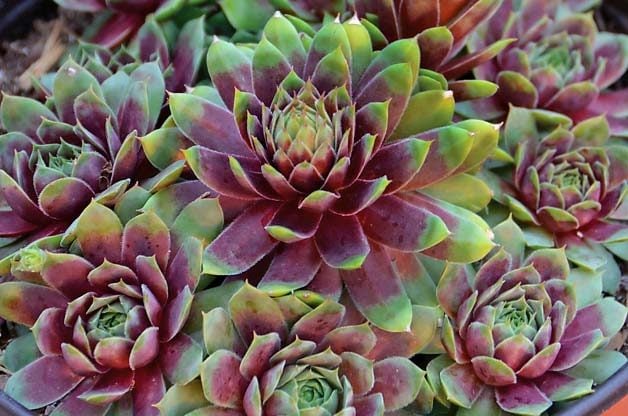
Q: I can’t seem to get hens-and-chicks to grow. I have tried for several years and still fail. What can I do to keep them alive? — Birds & Blooms reader Bonnie Partridge
Garden expert Melinda Myers says, “Hens and chicks grow best in full sun and well-drained soils. Gardeners who have heavy clay and poorly drained soils struggle to keep these and other succulents alive. Try growing them in a container filled with a well-draining potting mix. When cold weather hits, move potted hens and chicks into an unheated garage or bury the pot in the ground for winter to insulate the roots against your cold temperatures.”
Q: Help! Squirrels eat all of my hens and chicks. How can I stop them? — Birds & Blooms reader Pam Davis
Melinda Meyers writes, “Many squirrels are accustomed to the smells and sounds of humans, so scaring them away from your plants is quite a challenge, but certain tactics and repellents may provide relief. Place whirligigs, clanging pans or other distracting items around the plants. Try repellents that use smell or taste to fend off squirrels. Some gardeners report success with cayenne pepper. A variety of techniques will increase the likelihood of success. If none of these ploys work for you, cover the plants with netting or a makeshift wire-mesh cage that the squirrels can’t chew through. Once they move on to new eats, you can remove the cage—just keep it handy in case they return. In the future, protect plants before the squirrels start to dine on them.”
Is a donkey tail succulent invasive?
Where to Buy a Hens and Chicks Plant

Hens and chicks plants are available at most garden centers and online on Etsy. Some of our favorite varieties are Cosmic Candy Chick Charms red cobweb hens and chicks, and Gold Nugget (pictured above).
Next, check out the top 10 flashy flowering succulents to grow.
Small but speedy. Tiny but aggressive. Little bodies, big appetites. Hummingbirds are a study in extremes. They are the lightest North American birds. Most weigh less than two pennies at 3 to 4 grams. They have the fastest wings and heartbeats, the most efficient metabolisms, and the most minuscule eggs. The list could go on. Watching these tiny marvels at a feeder, it’s hard not to wonder how hummingbirds zip around so quickly or keep their feathers so brilliant. Hummingbirds are tough survivalists. Many of the actions that help them persevere also make them fun to watch. Here are fascinating hummingbird facts about the traits and behaviors you might witness.
1. What Foods Are in the Hummingbird Diet?

You typically see hummingbirds at nectar blooms and sugar-water feeders, but they also eat tree sap and small insects when flowers are hard to find in the wild. Nectar is the high-octane nourishment that fuels hummingbirds, but they also need body-building protein. They spend considerable time hunting and eating the small insects, spiders and other arthropods that provide the vital compound. Thanks to the fliers’ amazing agility and the special adaptation that essentially makes their bills spring-loaded sets of chopsticks, hummingbirds snatch insects out of the air. Hovering, they also glean earthbound prey from spiderwebs, vegetation and other places. Sweet oozing tree sap has a high sugar content, not unlike nectar, so it’s also ideal for hummers—but they can’t access it without a little help. Sapsuckers drill holes into trees for their food, creating rows of sap wells. Some hummingbird species readily feast on the sap from these wells.
Check out questions about hummingbird feeders answered by experts.
2. Hummingbirds Lap Up Nectar and Sugar Water
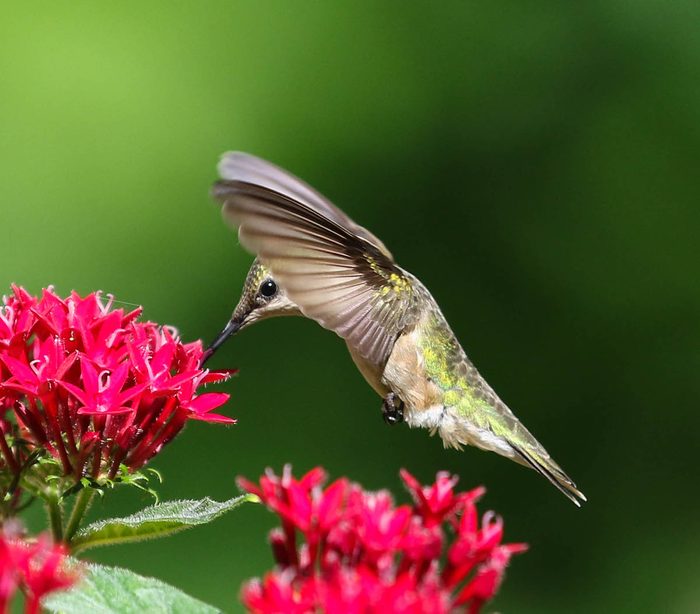
A casual observer might suggest that hummingbirds use their long, thin, dainty beaks like straws. Their tongues function as a tiny pump to suck the sought-after sweet liquid from feeders and flowers. Each bird has a thin tongue that forks at the tip, springing open to gather fluid; then the tongue retracts as the bill squeezes shut, compressing the tongue and allowing the bird to lap up the nectar. Hummers repeat this 15 to 20 times per second.
Hummingbirds will flock to a hummingbird mint plant.
3. Do Hummingbirds Return to the Same Place?

If you think the same hummingbirds come back to your feeders and flowers every year, you might be right! Banding research shows they are likely to return to the area where they hatched.
When should you put out hummingbird feeders in spring?
4. Hummingbirds Are Long Distance Migrants
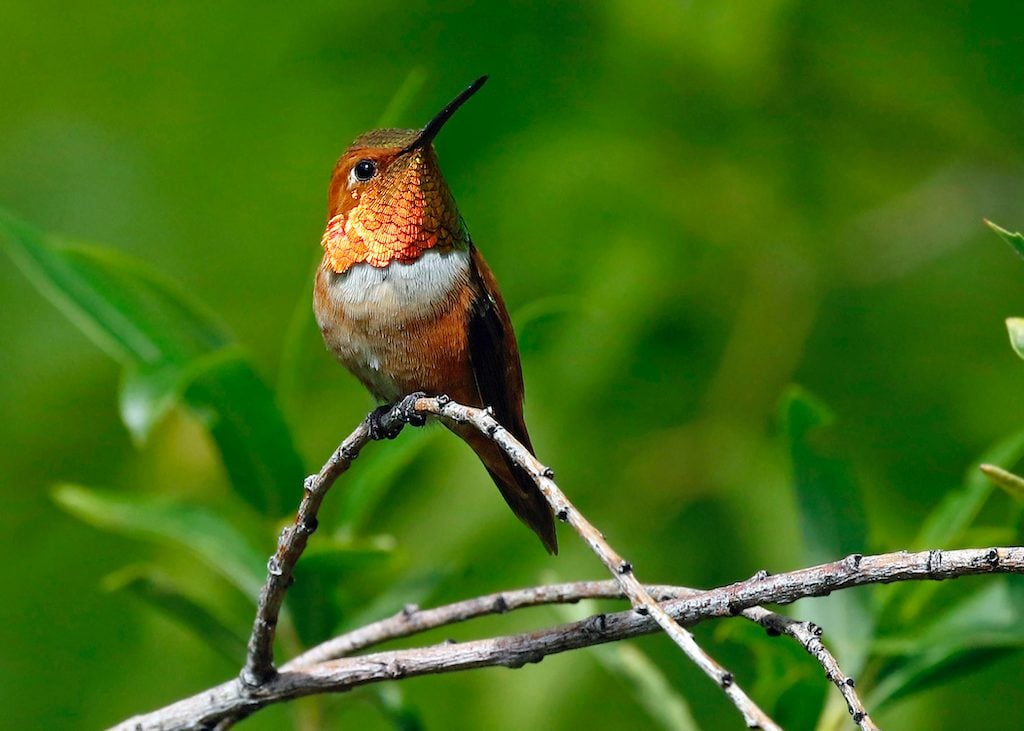
Another one of the most interesting hummingbird facts: Rufous hummingbirds migrate farther than any other North American species. They travel 4,000 miles from Mexico to Alaska every spring.
How do hummingbirds survive snow and cold weather?
5. Hummingbirds Migrate Alone
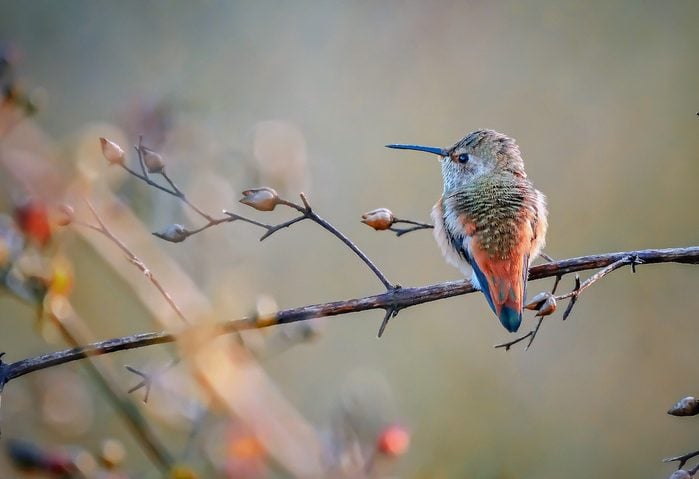
Hummingbirds are solitary migrants, so you won’t see them traveling in flocks. Wintering grounds vary by species. Most ruby-throats spend the cold months between southern Mexico and northern Panama. This is why you should keep feeders up for late migrating hummingbirds.
Read the sweet stories behind these cute hummingbird photos.
6. There Are Hundreds of Hummingbird Species

All of the approximately 340 living hummingbird species are entirely and uniquely North and South American. They live anywhere from Alaska to the southernmost tip of South America. They’re so varied that adjectives from the expanse of the dictionary are insufficient to describe these bird species. However, only 15 types of hummingbirds are regularly spotted in the United States. Discover the colorful hummingbirds of Costa Rica.
7. What Color Are Hummingbirds?

Hummers vary tremendously in the color and arrangement of their iridescent parts. Even among the handful of hummingbird species that are widespread in the United States, the array of colors is impressive. The male Allen’s and rufous hummers have blazing red-orange throats. The beautiful male Anna’s hummer has an incredible iridescent magenta throat, face and crown. And the closely related Costa’s hummingbird, whose neck feathers taper into long mustache-like points on each side, has a head wrapped in royal purple.
P.S. Did you know hummingbirds can fly backwards?
8. What Are the Colorful Patches on Their Necks?
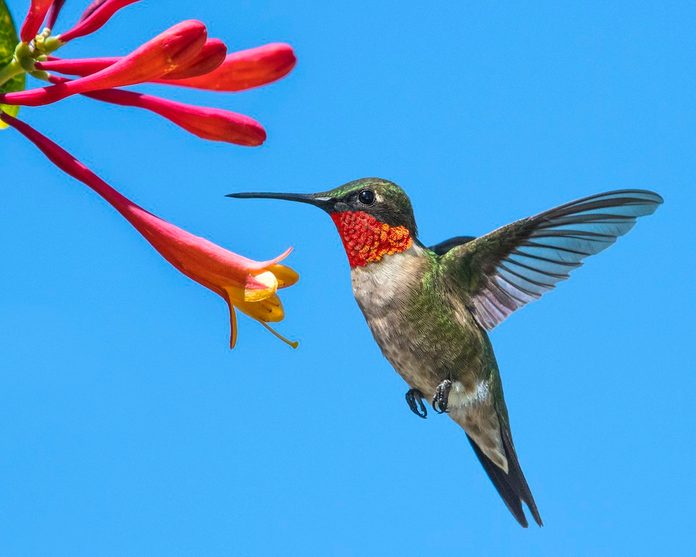
With just a turn of its head, a hummingbird explodes in iridescent radiance. Its gorget (the patch of colorful feathers covering its throat) instantly blazes in shades that span the color spectrum, depending on the species. These dazzling colors come from the feather structure rather than pigmentation. Each iridescent feather has tiny spikes that are densely packed with many layers of microscopic structures filled with air bubbles. These structures reflect light, says Bob Sundstrom, a science advisor for BirdNote, “creating color in the manner of sun glinting off an oily film on water.
Do hummingbirds mate for life?
9. Hummingbird Nests Are Tiny
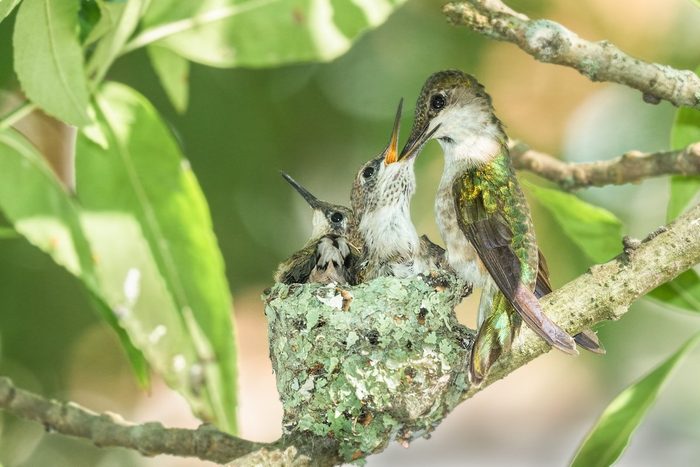
Even if you know many hummingbird facts, it’s a special treat to find one of their nests. The average nest is about the size of a half-dollar coin. The eggs inside the tiny structure look like mini white jelly beans. Here’s everything you need to know about hummingbird nests.
10. Hummingbirds Build Nests With Spiderwebs
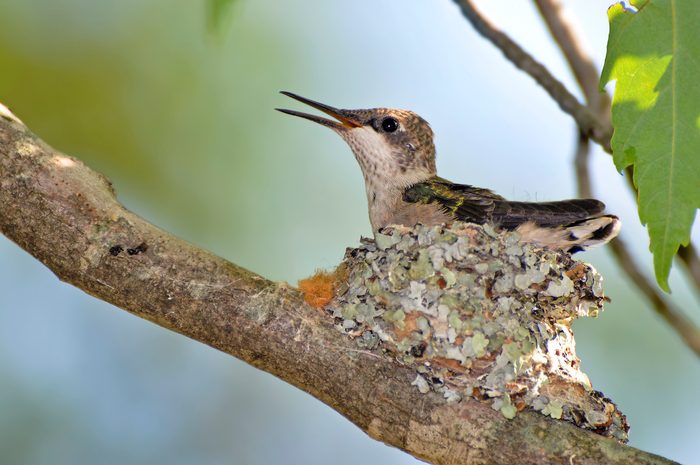
It takes less than a week (about five to seven days) for a hummingbird to build its nest. Built by females only, nests are made of lichen, moss, and spiderwebs. Check out 10 adorable pictures of baby hummingbirds.
11. Hummingbirds Are Aggressive

Despite their tiny size, hummingbirds can be very territorial. They spend a lot of time chasing other birds away from the feeders or flowers they’re protecting.
“Birds that drink nectar tend to be aggressive,” Chris says. Researchers’ best hypothesis is this: Most birds need to find their food—hidden seeds or grubs—but hummingbirds feed on flowers that are showy by nature. That means they can see all their food sources, but so does the competition. “They evolved to be really aggressive defending that food from other animals that might also eat it,” Chris says.
Learn more about hummingbird behavior.
12. How Do Hummingbirds Choose Flowers?

Another fascinating hummingbird fact—they have superb visual acuity. They see color even better than we do, with their vision extending into the ultraviolet spectrum. Their eyes are adapted to see warm shades better than cooler shades. This ability to easily pick out orange, yellow and red flowers amid a sea of cool green led to the long-held assumption that they prefer red over other colors. Scientists have since learned that the richness of the nectar matters more than the color of its source. The birds are quick learners, and it is nourishment they are after. With the right flowers and feeders, you can attract them to your yard, too. Just make sure you don’t have any of these plants hummingbirds dislike.
13. Hummingbirds Take Quick Breaths

While resting, the average 4-inch hummingbird takes about 150 breaths per minute. Discover the truth about common hummingbird myths.
14. Hummingbirds Can Hover and Fly Backward

Stun your friends with these hummingbird facts. No other bird can match the hummingbird for agility on the wing. They can hover in midair at flowers and feeders, and they’re the only birds that can fly backward. Their wings move in a figure-eight pattern, which allows them to maneuver with ease. Other birds create the lift needed for flight with each downstroke of their wings. In other words, typical bird flight is achieved by flapping the wings up and down.
It’s not the speed of its wings that allows a hummingbird to hover—it’s the structure of its wing joints. Hummingbirds can rotate or twist the upper arm bones to invert their wings as they flap. This lifts them into the air on both the upstroke as well as the downstroke. The result? They are the most agile birds on the planet.
Meet the calliope hummingbird: the smallest bird in the U.S.
15. How Fast Do Hummingbirds Fly?

A hummingbird’s namesake hum is created by air moving around its wings. Known for erratic and agile movements, hummingbirds beat their wings more than 50 times per second, and even faster in extreme flight mode. They’re also among the fastest fliers for their size, reaching speeds of up to 37 mph, and up to 60 mph in courtship dives.
Psst—this is how long hummingbirds live.
16. Some Hummingbirds Sing
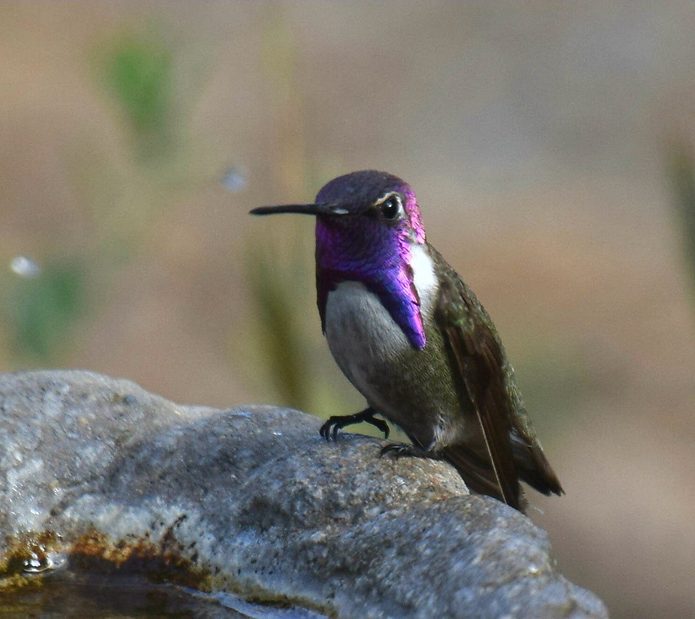
Though not as vocal as songbirds, it’s a hummingbird fact that some species, specifically male Anna’s and Costa’s, are regular singers. With other species, the most common sounds are aggressive calls, which resemble chattering or squealing. You’ll hear them when several hummingbirds are gathered near a food source. Learn more about the many sounds of hummingbirds.
17. Whirring Tail Feathers

Soon after Chris Clark, an associate professor at the University of California, Riverside, began studying Anna’s hummingbirds, he wondered about their tails. “They’re these little fighter jets,” he says. “What are they doing evolving these really long tails that might slow them down?”
He discovered in his research that the stiff tail feathers of male Anna’s make songlike sounds. These noises are part of the courtship display as the males dive to attract females’ favor. The wings of hummingbirds make different sounds—what Chris calls wing trills. “On broad-tailed hummingbirds, the males have this little notch in the outer part of their wings,” he says. “They sound like a cricket when they fly.” Other species, including Allen’s, rufous, and to a lesser extent ruby-throated and black-chinned, also have these trills. And in these birds, the trills are in place of songs, Chris says, with males using the sounds to declare and defend territory. Here’s how you can help hummingbirds in extremely hot weather.
18. Hummingbirds Love Bird Baths

A birdbath with a small mister, bubbler, or sprayer attracts hummingbirds. It’s a rare sight, but they might fly through the mist of a lawn sprinklers, too! Hummingbirds meticulously preen their feathers. In that respect, they are like race car drivers who take immense care to keep all parts of their automobiles in perfect working order. Hummers love to take a shower—or even a bath—using water to help clean their plumage, and they are attracted to gardens with water features, intentional or not. Of course, hummers visit bird baths and other standing-water features as well.
Will hummingbirds use a birdhouse?
19. Hummingbirds Have Olympic Metabolisms

Hummingbirds actively defend their food sources because they need to feed every 10 to 15 minutes. Flying is an energy-intense endeavor for hummers. In the process, they ingest levels of sugar that would be dangerous to other animals. That’s what led Ken Welch Jr., an associate professor at the University of Toronto Scarborough, to study hummingbird metabolism. “Hummingbirds maintain a blood sugar level, even when they’re fasting, that would make your primary care physician falter,” Ken says. Hummingbirds have highly efficient digestive organs. The sugar gets into their bloodstream quickly, Ken says. “The average hovering metabolic rate of an Anna’s hummingbird is, gram per gram, about 10 times what an elite human endurance athlete can achieve,” Ken says. And that extremely fast metabolism also can plummet when the birds go into torpor to conserve energy or bulk up before migration. “They can go from the highest metabolic rate of any bird while hovering, to one of the lowest in torpor,” Ken says. A study in hummingbird facts and biological extremes, indeed.
Grow potted flowers and plants that attract hummingbirds.
20. How Hummingbirds Spend Their “Free Time”
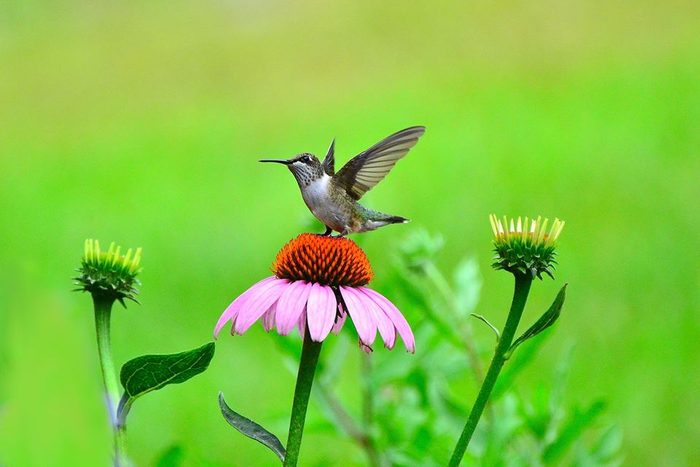
Q: How do hummingbirds spend their time when they aren’t at a feeder? – Birds & Blooms reader David Worrell
Birding experts Kenn and Kimberly Kaufman write, “Even in a yard that is well-stocked with sugar-water feeders, hummingbirds will regularly visit any flowers that are available and catch tiny insects to supplement their diet. In the breeding season, the females are extremely busy with building a nest, incubating eggs and feeding their young. Male hummingbirds don’t take any part in nesting or chick-rearing duties. Instead, they spend most of their spare time chasing away rival males or watching for females so they can resume courtship activities.”
21. Groundbreaking Hummingbird Photography
In August 1947, National Geographic published a series of photographs by Harold Edgerton of a ruby-throated hummingbird frozen in flight. The photos represented a groundbreaking invention important to our appreciation of hummingbirds today—the creation of the electric flash, which could emit a burst of light that lasted 1/100,000 of a second. That made it possible to capture images our eyes couldn’t see, including a hovering hummingbird’s wings. This allowed bird enthusiasts to learn hummingbird facts and appreciate these tiny dynamos in detail previously unseen.
You need to see these 50 stunning hummingbird pictures.
22. The First Hummingbird Feeders
Another key invention was the feeder that attracted the attention of that ruby-throated hummingbird. It was a blown-glass sugar water feeder devised by Laurence Webster, who made it to feed hummingbirds in his New England gardens. National Geographic readers were immediately transfixed by the concept of feeding hummingbirds and wanted feeders of their own. In 1950 Audubon Novelty Company released the first commercially available hummingbird feeder and called it “the Webster Hanging Feeder.”
Psst—we found the best hummingbird gifts for any occasion.
Discover More Hummingbird Facts
Birds & Blooms joined forces with author John Shewey on a new book, The Hummingbird Handbook. Pick up a copy to learn even more fascinating and fun hummingbird facts. Here’s even more of our favorite hummingbird books.
How to Care for a Hoya Plant

Hoya, also known as wax plant, are known for their ease of care. They make a great plant for a new succulent gardener. Really, all a hoya plant needs is bright indirect sunlight and intermittent watering. Plants that are at least five years old are more likely to bear clusters of sweet-smelling blooms.
You’re sure to love these pink succulents for your home.
Hoya Heart Plant
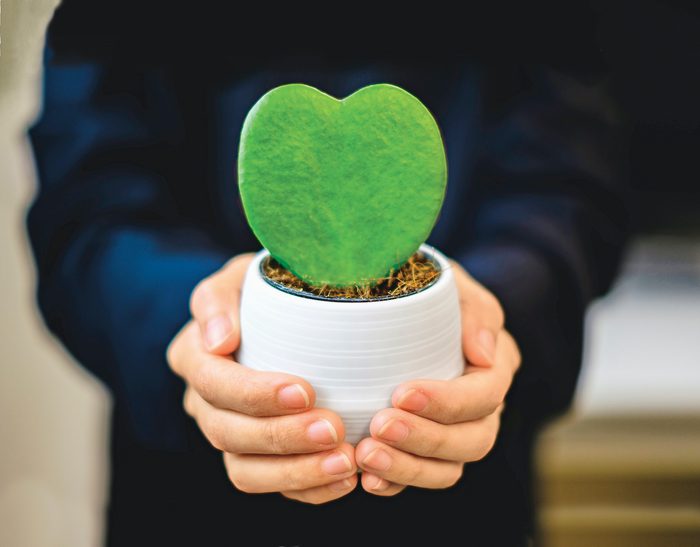
Another hoya favorite is the sweetheart hoya, or hoya heart plant, named for its adorable heart-shaped leaves. Gardeners typically place this succulent in a hanging basket or along a trellis. Like the rest of the hoya family, it only requires infrequent waterings and indirect sun. You can also grow a single leaf cutting like the one pictured above that will stay the same size in a small container for many growing seasons.
Discover the top 10 colorful succulents you should grow.
Repotting a Hoya Plant
It’s best to repot houseplants when they’re not in bloom. Wait to repot your potbound wax plant in early spring.
Hoya Plant FAQ

I have had this plant (above) for more than 16 years and it has not bloomed until now. What kind of plant is this and is it supposed to bloom? — Birds & Blooms Reader Linda Overdorf
Garden expert Melinda Myers says, “Your trailing houseplant is known as wax plant or hoya. This succulent grows best in a sunny window in well-drained soil. Use a flowering houseplant fertilizer during periods of active growth. Pot-bound plants growing in a cool location with slightly dry soil in winter and high humidity in summer are more likely to bloom. Be sure to leave the long leafless stem-end intact because this is where the flowers will form.
My indoor hoya used to bloom all the time, but when I moved, I had to cut 3 feet off the bottom. It seems happy in its new location, and yet it hasn’t bloomed. Why? — Birds & Blooms Reader Mary Ann Fecteau
Melinda Myers writes, “Congratulations on growing a hoya that bloomed not once but several times throughout the year. You obviously had a great location and provided proper care. Severe pruning of any plant, including your hoya, stimulates vegetative growth (leaves and stems) and delays flowering. Provide the same care and be patient. It may take a few years for your plant to adjust to its new home and switch back into a reproductive, or flowering, mode.”
For more succulent care tips, check out our expert’s advice on how to tell what’s wrong with your succulent.
Peanut Wreath Blue Jay Feeder
Attract more backyard birds by feeding peanuts. Blue jays are very smart and they will gladly take on the challenge of removing whole peanuts in the shell from this metal wreath feeder. And you’ll enjoy watching them!
Here’s how to identify and attract blue jays.
Peanut Picnic Table Feeder
Watch the blue jays enjoy a peanut picnic on this adorable picnic table feeder. The table includes a blue enameled steel bowl that you can easily remove for cleaning. Squirrels or chipmunks may also stop by for a visit and a nutty snack. Keep in mind that this feeder does not have a hanging hook, however, you can mount it to a fence or place it on a flat surface.
Blue Jay Tray Feeder
This tray feeder is perfect for the ultimate blue jay lover. The bottom half is a tray feeder with a mesh bottom for drainage, which we know these loud, boisterous birds prefer. The top half, shaped out of wood to look like a flying jay, offers shade and protection from rain.
Meet the Steller’s jay: clever black and blue birds.
Blue Jay Bird Feeder
Fill this blue jay feeder up with sunflower seed to attract clever jays (and more beautiful songbirds like finches, grosbeaks, titmice and cardinals) to your backyard.
Want to attract redbirds? Check out the best cardinal bird feeders and birdseed.
Lighthouse Shaped Peanut Feeder
Sometimes it seems like blue jays have special peanut vision, so give them a beacon in the backyard. This lighthouse shaped bird feeder holds a large amount of shelled peanuts, so there will be plenty to go around for the woodpeckers, nuthatches and blue jays. The durable metal mesh will deter squirrels from chewing on it.
Here’s why the blue jay’s range is expanding westward.
Gray Bunny Peanut Feeder
Have a smaller bird feeding station but still want to attract blue jays? Try this classic tube shaped peanut feeder. It’s so easy to refill and clean, plus serving a smaller amount at a time means the peanuts won’t spoil. Smaller peanut eating birds like red breasted nuthatches and downy woodpeckers will love it, too.
Psst—these are the best-selling bird feeders of 2022.
Woodlink Platform Bird Feeder
Jays are large backyard birds, so this open platform feeder gives them plenty of space to spread out while they search for a meal. Mourning doves also prefer these feeders.
Don’t miss the best finch feeders to serve thistle seed.
Is a Donkey Tail Succulent Invasive?

Q: I found this plant in late December in Wisconsin and it was still green. What is it? asks Birds & Blooms Reader Michael King.
Garden expert Melinda Myers writes, “Depending on the region, some gardeners prize this plant and others avoid it for its invasiveness. Known as donkey tail or myrtle spurge (Euphorbia myrsinites), the succulent is banned in several western states because it spreads quickly, crowding out native plants.”
Hardy in Zones 4 to 8, it thrives in heat, full sun and well-draining soil. Yellow star-shaped flowers appear on the tips of the branches and are surrounded by a yellow-green or green bract. It reseeds readily and can quickly take over a garden. Remove the fading flowers to prevent seeds from forming.
Learn how to propagate succulents (for more free plants!)
Choose This Donkey’s Tail Succulent Instead

You might be surprised to learn that more than one plant is known by the common name donkey tail. The more common succulent, Sedum morganianum, also known as burro’s tail, will thrive year-round when grown indoors. Make sure you check the botanical name to ensure you are getting the correct plant! Keep in mind that this succulent doesn’t usually bloom as a houseplant.
If you’re looking to add this sedum to an outdoor succulent garden, the best time to plant it is in early spring or when temperatures are consistently above 40 degrees Fahrenheit. It won’t typically survive a winter outdoors in cold climates, though, so you’ll have to overwinter it inside. This plant will not spread or take over like myrtle spurge.
Like many succulents, donkey’s tail can be finicky about how much water it receives, so it’s best not to give it too much. Plant it in sandy soil (or cactus soil) in a pot or planter that allows excess water to drain. Place your plant in direct sunlight. Donkey’s tail drops its too-cute leaves easily, so it’s best to set it somewhere where it won’t be disturbed.
Next, learn how to grow Autumn Fire sedum for late season color.



